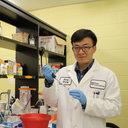Delayed peripheral administration of a GPE analogue induces astrogliosis and angiogenesis and reduces inflammation and brain injury following hypoxia-ischemia in the neonatal rat.
Açar sözlər
Mücərrəd
Glycine 2-methyl proline glutamate (G-2mPE) is a proline-modified analogue to the naturally existing N-terminal tripeptide glycine-proline-glutamate that is a cleaved product from insulin-like growth factor-1. G-2mPE is designed to be more enzymatically resistant than glycine-proline-glutamate and to increase its bioavailability. The current study has investigated the protective effects of G-2mPE following hypoxic-ischemic brain injury in the neonatal brain. On postnatal day 7, Wistar rats were exposed to hypoxia-ischemia (HI). HI was induced by unilateral ligation of the left carotid artery followed by hypoxia (7.7% O2, 36 degrees C) for 60 min. The drug treatment started 2 h after the insult, and the pups were given either 1.2 mg/kg (bolus), 1.2 mg/ml once a day for 7 days, or vehicle. The degree of brain damage was determined histochemically by thionin/acid fuchsin staining. G-2mPE's anti-inflammatory properties were investigated by IL-1beta, IL-6, and IL-18 ELISA, and effects on apoptosis by caspase 3 activity. Vascularization was determined immunohistochemically by the total length of isolectin-positive blood vessels. Effect on astrocytosis was also determined in the hippocampus. Animals treated with multiple doses of G-2mPE demonstrated reduced overall brain injury 7 days after HI, particularly in the hippocampus and thalamus compared to vehicle-treated rats. The expression of IL-6 was decreased in G-2mPE-treated animals compared to vehicle-treated pups, and both the capillary length and astrogliosis were increased in the drug-treated animals. There was no effect on caspase 3 activity. This study indicates that peripheral administration of G-2mPE, starting 2 h after a hypoxic-ischemic insult, reduces the degree of brain injury in the immature rat brain. The normalization of IL-6 levels and the promotion of both neovascularization and reactive astrocytosis may be potential mechanisms that underlie its protective effects.



